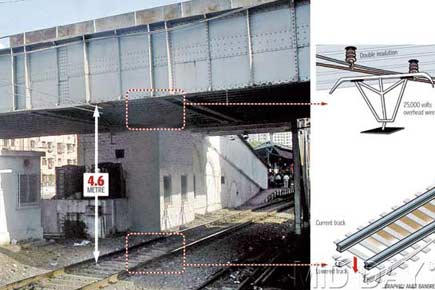At a crossover north of Thane, a technical snag could block three railway lines at one go; on the main CST-bound stretch, old bridges passing over tracks pose a problem

Trains plying between Kalyan and Thane and Thane-Kurla LTT (5th - 6th lines) got more juice when they were upgraded from a 1500V DC supply to a 25,000V AC power supply. Now, the Central Railway (CR) authorities have two problems to rack their heads over the first is just outside Thane station on the northbound stretch, till where the conversion has been completed, and the second, an issue in the conversion to AC lines on the Thane-CST stretch due to old bridges passing over the railway tracks.

Graphic/Amit Bandre
ADVERTISEMENT
Option A
Conversion to AC requires the bridges to be lifted hydraulically. Since the stone bridges cannot be lifted, technicians will use a process called ‘condonation’. In this, the wires will have double insulation protecting them from the bridge.
Option B
The other option is to lower the level of tracks to carry out the conversion process above. But this lowered set of rails may get flooded during the monsoons.
Trouble at Thane
After a gruelling night on January 11-12, where nearly 2,000 gangmen and officers toiled under halogen lights converting the system, work was completed between Kalyan and Thane (just before the platforms at Thane) to switch to AC power. But there is a catch. There is a small stretch just north of Thane station called a neutral section.
This particular stretch creates a cushion between the line that supplies 1500V (Thane to CST) and another that starts supplying 25,000V (Kalyan to Thane). On this stretch, the train doesn’t receive any power supply and instead moves ahead due to its momentum. “The neutral section is 4 metres after Thane station (towards Kalyan). This, however, comes on a crossover,” said a senior CR official, on condition of anonymity.
A crossover mainly helps a train switch tracks – fast to slow and vice versa. At most crossovers, trains have to negotiate a speed of 15 kmph. This has become a matter of concern for CR authorities – if the train were to develop a technical snag while manoeuvering over the tracks at such low speeds and switching power supplies, it would end up blocking three lines at a time. This portion is likely to affect train services operating from platform numbers 4, 5, and 6.
Wary of snags
Sources said that they are only hoping that the train passes safely when passing this neutral section and that it doesn’t undergo any technical snags. “We have asked higher authorities to permit speeds up to 30 kmph,” added the official. This is to let the train pass over and avoid an unwanted halt in the crucial section. After the conversion on Sunday, the 25,000 V AC territory starts from south of Mumbra on the slow track, while north of Thane station on the fast track. Presently trains, especially semi-fast ones that turn into slow trains after Thane, change tracks using this crossover near Thane station and proceed to Kalyan.
Even trains coming to CST, at times, use the neighbouring crossover, both of which are nearly 300 metres in length. In case of any snag while crossing, a train could halt, blocking all three lines at the same time, causing chaos. Meanwhile, officials are travelling with motormen to ensure a smooth switching of power supply and to accustom them with the process to prevent problems.
While entering AC territory, motormen need to switch on AC circuit breakers, and switch off the DC circuit breakers. A similar exercise needs to be carried out while entering the DC zone. A senior official said that they were planning a small conversion to 25,000 V AC till south of Thane station in the coming months to overcome this problem. They will also manufacture and introduce at least five retrofitted rakes that can operate on both DC/AC lines smoothly.
Bridges a burden
The next phase would be to come all the way till CST, thus pumping 25,000 V AC in the entire system on the main line. A different kind of problem is expected on this stretch, with the stone road and foot over bridges built over tracks at 20 different locations. These have been made to facilitate east-west crossing.Some of the most prominent locations where the CR authorities expect problems to crop up over power upgradation are Sandhurst Road, Chinchpokli, Currey Road, Dadar, Matunga and many other bridges along the route, which date back to the British era.
Sources at CR said that for upgrading, a minimum distance of 4.69 metres has to be maintained between the railway tracks and the bridge. The old structures are lower than the required gap. Hence, the railways will have to work around the problem and has two options to do so (See illustration for details). The deadline for completing work on the Thane-CST stretch is May 2014.
 Subscribe today by clicking the link and stay updated with the latest news!" Click here!
Subscribe today by clicking the link and stay updated with the latest news!" Click here!







